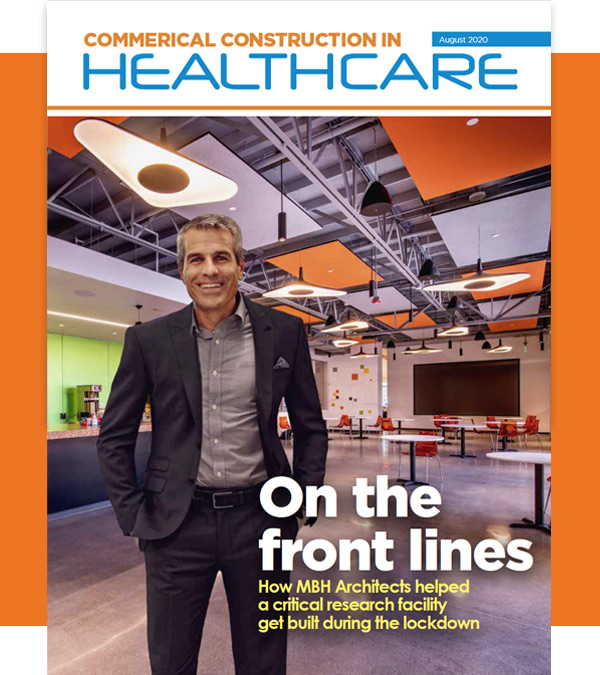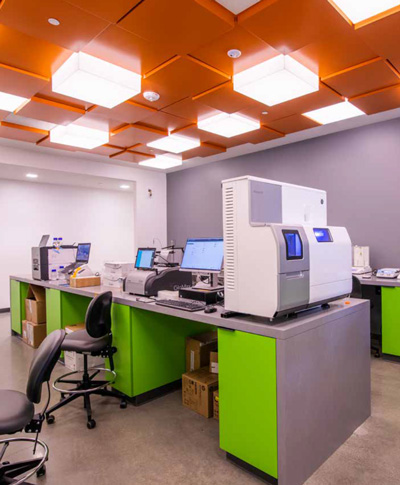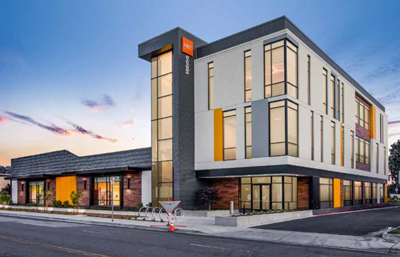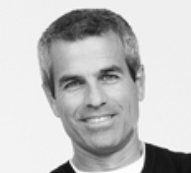
Commercial Construction & Renovation
August 2020, Vol.19, No.6, Page 69
By Michael J. Pallerino
Read original article
On the front lines
It has been called an entrepreneurial playground—a place that was designed for scientists, by scientists. MBC BioLabs is a full-service incubator offering laboratories, office space, meeting room and an in-house staffed CRO facility with millions of dollars’ worth of equipment.
 Right before the pandemic hit, builders were putting the final touches on the 930 Brittan Avenue facility—MBC BioLabs’ third—in San Carlos, California. Thanks to the passionate work of everyone involved in the project, which houses four laboratory spaces designed for life-science startups, the facility was completed this month. Interestingly, one of the startups focuses on coronavirus vaccine-related research programs.
Right before the pandemic hit, builders were putting the final touches on the 930 Brittan Avenue facility—MBC BioLabs’ third—in San Carlos, California. Thanks to the passionate work of everyone involved in the project, which houses four laboratory spaces designed for life-science startups, the facility was completed this month. Interestingly, one of the startups focuses on coronavirus vaccine-related research programs.
MBC BioLabs started in 2006 when Doug Crawford repurposed a utility room at the Mission Bay campus of the University of California. The QB3 Garage was born. As the first technology incubator in the UC system, the Garage was met with much skepticism. But of the first six start-ups, four raised Series A venture funding and a fifth was acquired for $25 million – and all within the first two years.
As word spread, entrepreneurial scientists were drawn to the easy access of lab benches, equipment and camaraderie. Sensing the magic, Crawford leased and transformed a warehouse in San Francis-co in 2013. The result was MBC Bio-Labs. Today, with more than 50 resident companies, an extensive list of successful alumni companies, and the new location in San Carlos, MBC BioLabs is the premier biotech incubator in the Bay Area.
One of the firms involved in helping complete the project was MBH Architects, a full-service architectural firm headquartered in a LEED Gold office in the San Francisco Bay area with offices in New York City, Denver, Mumbai and Bengaluru. The firm has worked on more than 10,000 projects of nearly every project type.
We sat down with Andres Grechi, Principal and Design Director at MBH Architects, to get his insights on how his team helped complete a facility that may prove to be a game-changer in the fight against the COVID-19.
Give us a snapshot of the MBC BioLabs project.
We were first introduced to the project through long-time collaborator, Dewey Land Company, a developer that had partnered with MBC BioLabs in the past. Fast forward to today, our team has completed ground-up and renovation projects for MBC BioLabs throughout the San Francisco Bay Area and continues to partner on the development of new facilities with both MBC BioLabs and Dewey Land Company.
In regards to the laboratory at 930 Brittan Avenue in San Carlos, California—the new facility is MBC Biolabs’ third campus. It houses four laboratory spaces, which are each being utilized by life-science startups, including those focused on coronavirus vaccine-related research programs.
We began the initial design phase for the laboratory in 2017 and completed the project in August 2020. The development, which consisted of three warehouses that were renovated and combined into a single facility, now includes a new ground-up three-story addition.”
What were the goals of the project? How did they change when the pandemic hit?
 The main goal was to empower entrepreneur scientists by providing them with a state-of-the-art facility to accelerate their scientific innovations. While finalizing construction earlier this year, we were hit by the coronavirus pandemic, but our goal did not change. Seven Bay Area counties were among the first in the nation to implement a shelter-in-place order, with the entire State of California following suit shortly thereafter.
The main goal was to empower entrepreneur scientists by providing them with a state-of-the-art facility to accelerate their scientific innovations. While finalizing construction earlier this year, we were hit by the coronavirus pandemic, but our goal did not change. Seven Bay Area counties were among the first in the nation to implement a shelter-in-place order, with the entire State of California following suit shortly thereafter.
Within the first week, MBC BioLabs and Dewey Land Company moved to have the project at 930 Brittan deemed essential. Due to the need for laboratories in the populous Bay Area, construction was permitted to continue and reach completion in August. Now, the new laboratory is home to four companies—two of which are nonprofits—that are devoted to developing fast, accurate and budget-friendly COVID-19 tests.
In fact, one company recently was awarded a National Institutes of Health Rapid Acceleration of Diagnostics (NIH RADx) grant to continue its important work. Ultimately, MBC BioLabs’ mandate is to increase the number of SARS CoV-2 tests from about 0.5 million per day to over five million per day by mid-September.
Tell us about the immediacy of the construction deadline. How did that factor into the planning?
As soon as the pandemic hit and just about every construction project went into lock-down, we realized the construction schedule could be in jeopardy, so we consulted with city officials and received permission to continue construction—being this was a laboratory. With the need for scientists, testing and vaccine research, we received essential working permission.
What goes into enacting a design and construction plan at that pace?
With the luxury of time gone, one has to act fast and respond quickly to any questions from the field. RFIs become much more important and critical to keeping with the construction speed.
What special precautions (protocols) were put into place?
The contractor instituted a safe environment that included wearing masks at all times as well as random temperature checks. Addition-ally, MBH made its own site visit protocol for design teams to follow prior to visiting the site, including temperature checks, social distancing and wearing masks at all times.
How much of these protocols will become permanent moving forward?
I am sure wearing masks will continue to be the norm, both in construction processes and 930 Brittan’s future operations. At 930 Brittan, we also installed built-in fever monitoring devices in the ceiling of all entrances which scan each person that enters the building for a fever. These devices will remain in the building for use beyond the pandemic to keep the laboratories hygienic and clean.
Were there any challenges?
Every project has its challenges, and 930 Brittan faced the same ones any project did before the pandemic. It also had the added layer of being completed in a time of increased health concern and social distancing. We were navigating construction in circumstances none of us have dealt with prior, forcing us to adapt our rhythms and problem-solve daily.
How does the overall design of the lab cater to what the facility managers were looking for?

To reinforce brand cohesion across locations, the design team is using many of the same materials and colors across other projects for MBC BioLabs. A standout indoor/outdoor event space can be utilized for wellness activities or gatherings, and has been a much welcomed addition that employees enjoy regularly.
As laboratories are energy-dense environments, our team worked closely with MBC BioLabs to ensure all lab equipment appliances were Energy Star-rated. In addition, 930 Brittan’s roof top is equipped with solar panels to help with energy production—a Bloom Energy Box eventually will be installed once an additional MBC BioLabs’ building has been completed adjacent at 1030 Brittan. This will help the new lab campus form its own microgrid by converting fuel into electricity through an electrochemical process.
What kind of conversations about the “new normal” are you having with your customers? Employees?
I do not think there is a new normal. I think we are all trying to be as flexible as possible and our customers are doing the same. We continue to provide our clients our best service as usual and that gives us a sense of normalcy.
With everything going on today, what is your short-term strategy? Long-term?
In the short-term, we are protecting our employees and clients by working from home, limiting site visits and meeting virtually. Our leadership is thinking ahead to office reopening but will not reopen until we feel confident we can reopen safely. We are monitoring city and county guidelines for each of our office locations daily.
In the long-term, we hope to restore our company work environment to what it was with the necessary changes to maintain safety. We have continued to provide our best service to our clients through the pandemic and will continue to do so in the future.
What is the best piece of advice you can offer to other firms on how to deal with what is happening right now?
Be as flexible as possible and be open to any change. No one has dealt with a situation like this before and we are all figuring it out together. If you had told me five months ago I would still be working productively from home now, I would not have believed you. No one knows what comes next, so we need to remain flexible with the circumstances and each other.
Give us a rundown of what you are seeing out there.
I see a lot more research and development projects on the boards, such as laboratories and health care facilities.
What is the biggest issue today related to the construction side of the business?
As a designer, the hardest thing for me has been the lack of physical contact with materials. It is crucial to be able to touch and see materials when selecting them for a design. Now that we do not have access to our materials library, we have lost that sensory experience when designing.
What about the continued importance of sustainability today? What are you doing?
Sustainability and environmental responsibility is important to MBH at its core. We introduce sustainable design elements in every one of our projects. At the end of the day, it is up to the client to provide financial support for sustainable choices.
What type of opportunities do you see moving ahead?
Laboratories and health care.
What are some of the things you expect to see if and when we get back to any type of normalcy?
I think that a flexible work environment for our employees will be critical, I do not see everyone being in the office five days a week when we reopen the office fully.
From what you are seeing out there, how would you say the industry is handling construction in this new landscape?
Construction has been adapting swiftly to new protocols. Scheduling has become more stringent to accommodate social distancing guidelines, but contractors have been able to adjust and continue moving projects forward.
What should we expect to see six, 12 months down the road?
I am hoping things will return to how they were six to 12 months ago. We will look back at this period as a learning experience and will slowly return to working and spending time together when it is safe—but not anytime sooner. Humans are social and adaptable beings, and we will find ways to socialize, work and enjoy yourselves again.
One-on-One with…
Andres Grechi, Principal, Design Director of MBH Architects
Describe a typical day.
I have an average of 10 Zoom meetings a day, from 7:30 a.m. onward. This can include checking in with my directors, meeting with new or current clients, evaluating projects and discussions with MBH leadership. During this moment, communication is the most important thing.
What is the biggest item on your to-do list right now?
Keeping in contact with everyone in the office. When we were in the office I would constantly be walking around, checking in with my teams. Those quick and effective informal check ins are now on zoom or phone. They are not only the biggest item but the most important task for me.
What is the most rewarding part of your job?
The moment one walks into a construction site and realizes that the sketch that was once on your desk is now a physical building. That never gets old.
What was the best advice you ever received?
“Never make your work your life. Work to live not live to work.”
What is the best thing a client ever said to you?
“You changed our lives for the better with this building.”
How do you like to spend your down time?
I try to get on the ocean every day. Often, I paddle outrigger canoes and surf. Being in the water is my therapy and I am very fortunate that I live close to it.

